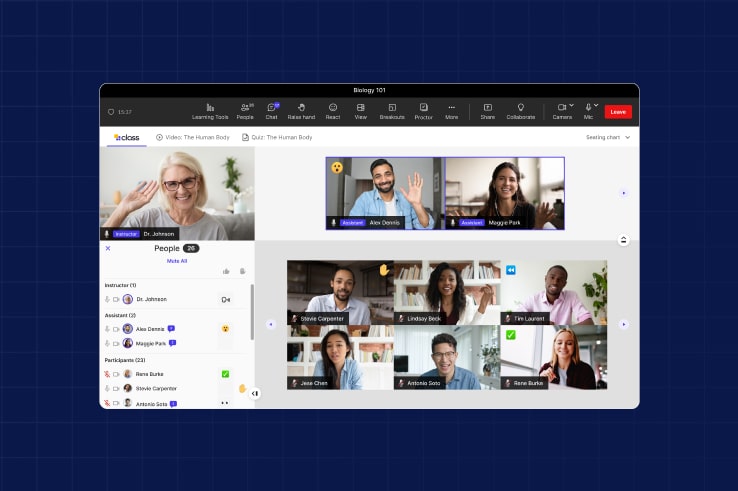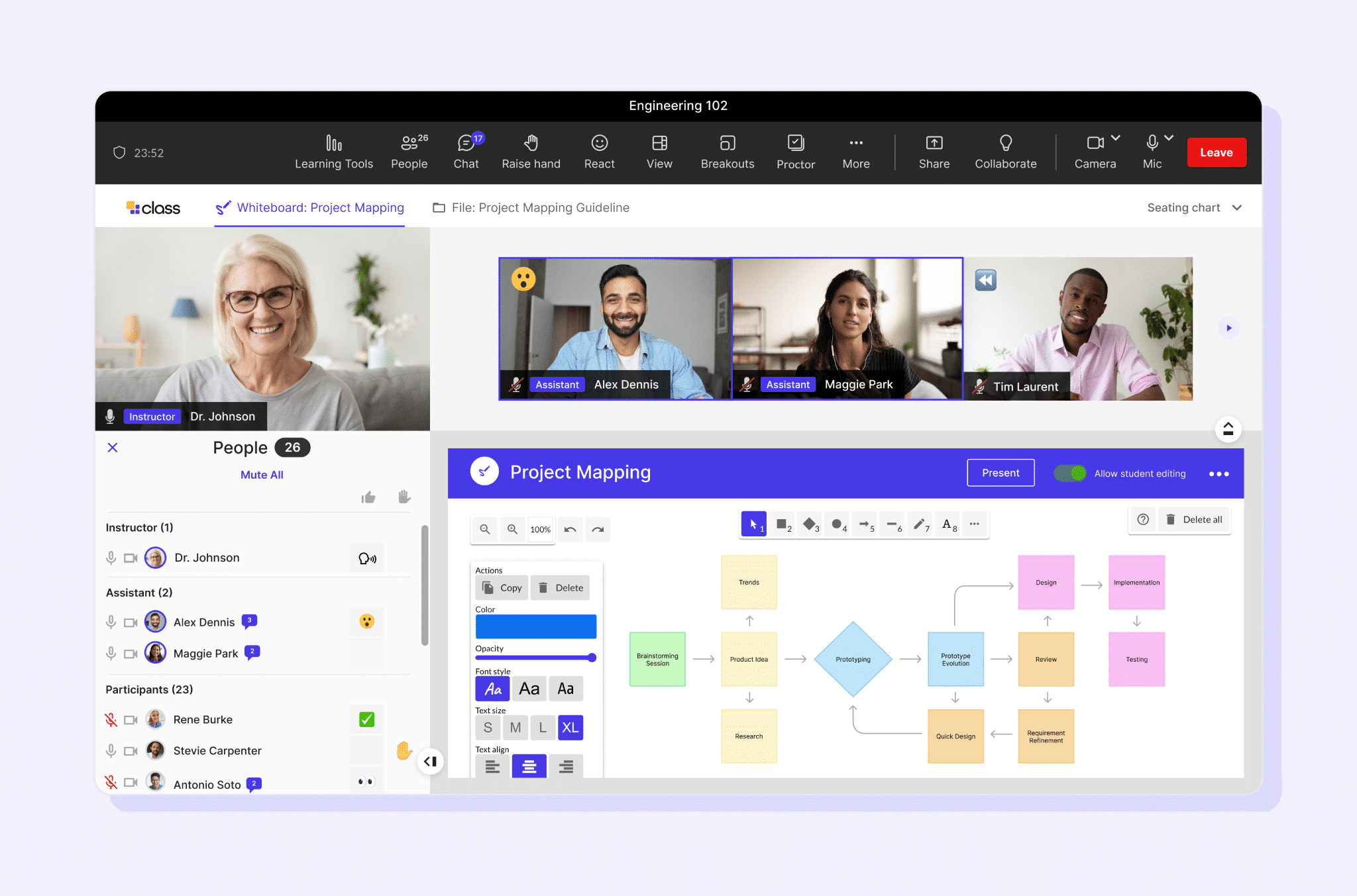
Michael Chasen is the co-founder and CEO of Class. He is an entrepreneur who has dedicated his career to improving the way people live and learn through technology. Chasen also served as co-founder and CEO of Blackboard Inc., a pioneering edtech company with software used by over 20,000 institutions and millions of instructors and learners worldwide.

Michael Chasen is the co-founder and CEO of Class. He is an entrepreneur who has dedicated his career to improving the way people live and learn through technology. Chasen also served as co-founder and CEO of Blackboard Inc., a pioneering edtech company with software used by over 20,000 institutions and millions of instructors and learners worldwide.

Ensuring an equitable experience for all learners has been at the heart of Class and our mission to change the way the world learns. Our partnership with Microsoft aims to do exactly this. I’m thrilled that we have had the opportunity to work with such capable, equally motivated partners to deliver on our mission—and Microsoft is chief among them.
The idea of Class and the next generation virtual classroom was born out of conversations with my kids, other young learners, and instructors during the COVID-19 pandemic. The need for video conferencing technology that is purpose-built for instruction is why we started Class and have built Class for Microsoft Teams.
Class for Microsoft Teams fully integrates with the Microsoft Teams environment and gives users the same type of interface that they’d utilize for virtual meetings, but modified to represent a virtual classroom, instead. The partnership between Class and Microsoft aims to provide an engaging and interactive virtual classroom environment that integrates with key LMS and third-party content providers.
We’ve built Class for Microsoft Teams with insights from educators and learners, alike. We took the instructor out of the “grid view” and put them on their own podium for central viewing and class management. We designed the video wall to be customizable, allowing instructors to organize alphabetically, or even by the order of hands raised.
We also provided features to replicate the physical orchestration of in-person learning, adding “front of room” to allow a learner or group of learners to present from a central location in front of the rest of their virtual classmates. We added hand-raising and other feedback features, even making them only viewable by the instructor to provide real-time feedback on pacing and more. There are so many additional features—from “all breakout rooms” views to in-platform launching of videos, websites, and LMS-based quizzes, and from automated attendance and gradebook synching to proctoring views—which have served as difference makers for instructors and learners.

When creating the features that allow Class for Microsoft Teams to be so powerful, we wanted to ensure our technical improvements make learning more accessible and equitable to learners across the board. This is a priority shared by Paige Johnson, Vice President of Education Marketing at Microsoft, who believes a perspective shift is necessary at this stage:
“Is the technology serving to ensure that all learners are learning to the maximal capacity? Whether they’re in a primary or secondary institution, a higher education institution, or a corporate environment, I think we can all agree that the reason that we’re trying to leverage technology is to help all learners build competencies. And I think with the era of AI that’s upon us, the gift the pandemic has brought us with more access both to broadband and devices and software solutions—great ones like Class technology on top of Teams—we have an opportunity to really ensure that everybody gets access to supporting and learning the competencies that they need in order to thrive in an innovation economy.”
In this regard, part of what virtual classroom platforms can provide are deeper insights not available for analysis through in-person learning environments. This is one of the areas I get most excited about and see some of the greatest potential. I like to consider Class to be the “money ball of education.” We’re tracking all of the activity that happens in the virtual classroom just like we’ve seen the rise of analytical tracking in sports.
We track how long the instructor holds class, how long the instructor speaks, how long the learners speak, how long each individual learner speaks, how many times learners raise their hands, how many chat messages they send and receive, and much more. All of this can be summarized at a high level or be made available as a detailed report in a single class, across multiple classes, across programs, or any other sort of analytical breakdown deemed helpful. With these next-level insights, we can ensure every learner is being seen, that “yellow flags” are caught quickly and addressed, and that fewer learners fall through the cracks.
Related: The Next Generation Virtual Classroom—Now Available for Microsoft Teams
As technology continues to change how we think about education, training, and learning more broadly, it’s important to note the importance of instructors in this process. We’re extremely excited about upcoming feature releases, including our AI teaching assistant technology which will take detailed notes, answer learner questions alongside the instructor, and more; but, most notably, these tools are there to help facilitate learning—keeping capable, dedicated instructors at the heart of learning.
Johnson emphasizes this point well, pointing out what she believes to be the two most critical elements necessary for addressing learning that leverages technology to empower data-informed experiences for outcomes-based pedagogy:
“The first is the instructional expertise […] It takes a great instructor and potentially more instructional professional development to design instruction […] The [instructor] is still critical. This does not replace [instructors]. Great [instructors] make great learning environments. And the second [is] the data. The access to the data across all of our systems are really the key to gaining great insights. And so having tools and dashboards within software are helpful […] but having our IT teams also aggregate those data across multiple siloed systems to see progress in learning is the critical key to equity.”
I’m so excited about what virtual classroom technology and AI is going to do to truly open up education and learning more broadly. Johnson agrees, adding, “I couldn’t be more excited about the iterations that Class [for Microsoft Teams provides] because I think it’s a game-changer for how institutions and corporate learning organizations can really take advantage of something you’re already buying in your academic or enterprise licensing in M365. And so, I’m just really thrilled that we are able to collaborate and bring the benefits of both of our strengths and technologies to the market at this time.”
Class is incredibly excited to be partnered with Microsoft, especially with the strong commitment to online learning both our companies have had for years. I invite you to experience how bringing together these two types of technology—the backend infrastructure and scalability of Microsoft Teams with a more academic-focused or a corporate training-focused front end—really can make a difference in allowing institutions and individuals to successfully bring their teaching, training, and learning into an online classroom platform.
Interested to experience the power of Class for Microsoft Teams for yourself? Reach out to one of our team members today! Want to see my full discussion with Paige Johnson of Microsoft? Check out the full webinar here.

Michael Chasen is the co-founder and CEO of Class. He is an entrepreneur who has dedicated his career to improving the way people live and learn through technology. Chasen also served as co-founder and CEO of Blackboard Inc., a pioneering edtech company with software used by over 20,000 institutions and millions of instructors and learners worldwide.

Michael Chasen is the co-founder and CEO of Class. He is an entrepreneur who has dedicated his career to improving the way people live and learn through technology. Chasen also served as co-founder and CEO of Blackboard Inc., a pioneering edtech company with software used by over 20,000 institutions and millions of instructors and learners worldwide.
Get our insights, tips, and best practices delivered to your inbox

Sign up for a product demo today to learn how Class’s virtual classroom powers digital transformation at your organization.

Features
Products
Integrations